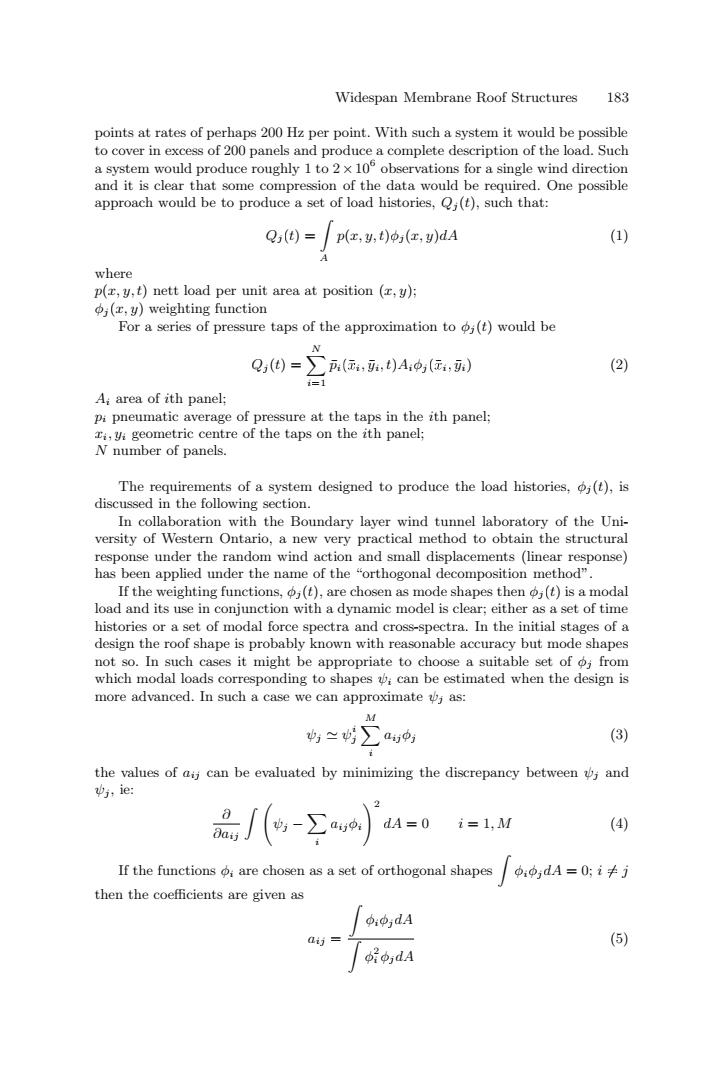正在加载图片...

Widespan Membrane Roof Structures 183 points at rates of perhaps 200 Hz per point.With such a system it would be possible to cover in excess of 200 panels and produce a complete description of the load.Such a system would produce roughly I to 2 x 10 observations for a single wind direction and it is clear that some compression of the data would be required.One possible approach would be to produce a set of load histories,Q;(t),such that: Q(t)= p(x,y,t)o(,y)dA (1) where p(,y,t)nett load per unit area at position (y); (r,y)weighting function For a series of pressure taps of the approximation to (t)would be N Q)=(元,,t)A:中(元,) (2) i=1 A;area of ith panel; pi pneumatic average of pressure at the taps in the ith panel; ri,yi geometric centre of the taps on the ith panel; N number of panels. The requirements of a system designed to produce the load histories,(t),is discussed in the following section. In collaboration with the Boundary layer wind tunnel laboratory of the Uni- versity of Western Ontario,a new very practical method to obtain the structural response under the random wind action and small displacements (linear response) has been applied under the name of the "orthogonal decomposition method". If the weighting functions,(t),are chosen as mode shapes then (t)is a modal load and its use in conjunction with a dynamic model is clear;either as a set of time histories or a set of modal force spectra and cross-spectra.In the initial stages of a design the roof shape is probably known with reasonable accuracy but mode shapes not so.In such cases it might be appropriate to choose a suitable set of from which modal loads corresponding to shapes i can be estimated when the design is more advanced.In such a case we can approximate v,as: M 4≈∑ (3) the values of aij can be evaluated by minimizing the discrepancy between and vi:ie: Di- dA=0 i=1,M (4) If the functions o;are chosen as a set of orthogonal shapes p:p,dA=0;i≠j then the coefficients are given as oiojdA (5) φipdAWidespan Membrane Roof Structures 183 points at rates of perhaps 200 Hz per point. With such a system it would be possible to cover in excess of 200 panels and produce a complete description of the load. Such a system would produce roughly 1 to 2×106 observations for a single wind direction and it is clear that some compression of the data would be required. One possible approach would be to produce a set of load histories, Qj (t), such that: Qj (t) = A p(x, y,t)φj (x, y)dA (1) where p(x, y,t) nett load per unit area at position (x, y); φj (x, y) weighting function For a series of pressure taps of the approximation to φj (t) would be Qj (t) = *N i=1 p¯i(¯xi , y¯i, t)Aiφj (¯xi , y¯i) (2) Ai area of ith panel; pi pneumatic average of pressure at the taps in the ith panel; xi, yi geometric centre of the taps on the ith panel; N number of panels. The requirements of a system designed to produce the load histories, φj (t), is discussed in the following section. In collaboration with the Boundary layer wind tunnel laboratory of the University of Western Ontario, a new very practical method to obtain the structural response under the random wind action and small displacements (linear response) has been applied under the name of the “orthogonal decomposition method”. If the weighting functions, φj (t), are chosen as mode shapes then φj (t) is a modal load and its use in conjunction with a dynamic model is clear; either as a set of time histories or a set of modal force spectra and cross-spectra. In the initial stages of a design the roof shape is probably known with reasonable accuracy but mode shapes not so. In such cases it might be appropriate to choose a suitable set of φj from which modal loads corresponding to shapes ψi can be estimated when the design is more advanced. In such a case we can approximate ψj as: ψj
ψi j *M i aijφj (3) the values of aij can be evaluated by minimizing the discrepancy between ψj and ψj , ie: ∂ ∂aij ψj −* i aijφi 2 dA = 0 i = 1, M (4) If the functions φi are chosen as a set of orthogonal shapes φiφjdA = 0; i = j then the coefficients are given as aij = φiφjdA φ2 i φjdA (5)